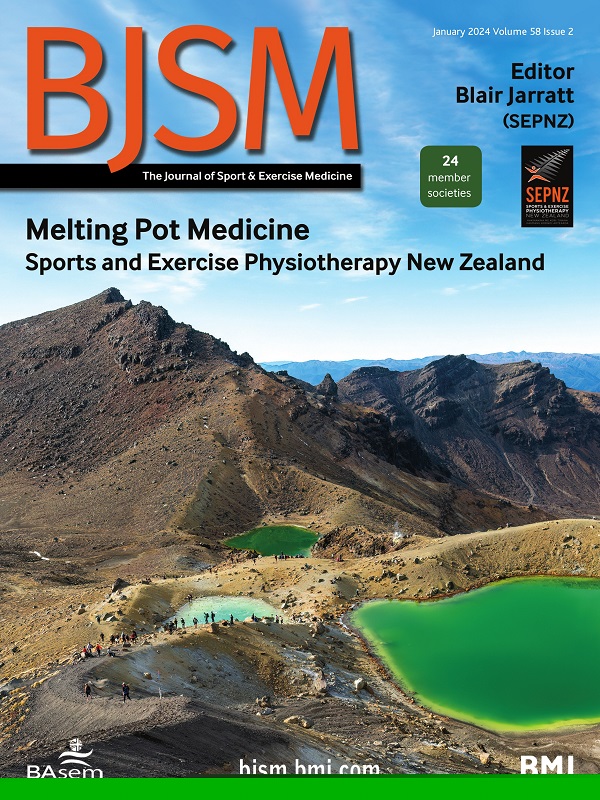头球指导:了解精英男子和女子足球训练中的头球需求
IF 16.2
1区 医学
Q1 SPORT SCIENCES
引用次数: 0
摘要
目的了解优秀足球运动员在使用牙套训练时的头球需求。方法方法遵循共识头部加速度测量实践指南。本前瞻性观察队列研究涉及来自英格兰足球一、三级四个俱乐部的52名优秀男球员,以及来自两个一级俱乐部的20名优秀女足球员。球员在外场训练时佩戴img来收集数据。一个线性混合模型用于识别基于性别、年龄和头球情况的头球指标的差异,分析了与头球频率和强度相关的13个不同指标。研究记录了63次训练中的1496次头球撞击。平均峰值(SD)头球强度为18.1 (8.5)g和1068 (776)rad/s2,平均冲击持续时间为10.4 (8.9)ms。男性运动员的平均峰值线性加速度(PLA)为17.8 (8.2)g,平均峰值旋转加速度(PRA)为1025 (741)rad/s2。雌性的PLA为20.1 (9.7)g, PRA为1374 (934)rad/s2。在旋转加速度方面存在显著的性别差异,女性玩家的数值更高(p=0.015,𝑛𝑝2=0.004),但在线性加速度方面则不然(p=0.152,𝑛𝑝2=0.001)。在不同的头球情况下,PLA和PRA也观察到显著差异,从抛头记录的最低值。对头球需求的理解对球员的健康和安全具有重要意义。这些信息可用于指导训练实践和头球负荷的量化。所有与研究相关的数据都包含在文章中或作为补充信息上传。本文章由计算机程序翻译,如有差异,请以英文原文为准。
Heading to guidance: understanding in-training heading demands for elite men’s and women’s football
Objective To investigate the heading demands of elite footballers during training sessions using instrumented mouthguards (iMGs). Methods Methods followed the Consensus Head Acceleration Measure Practices guidelines. This prospective observational cohort study involved 52 elite male players from four clubs in the first and third tiers of English football, and 20 elite female football players from two clubs in the first tier. Players wore iMGs during outfield training sessions to collect data. A linear mixed model was used to identify differences in heading metrics based on sex, age and header situations, analysing 13 distinct metrics related to heading frequency and intensity. Results The study recorded 1496 heading impacts across 63 training sessions. The mean peak (SD) heading intensity was 18.1 (8.5) g and 1068 (776) rad/s2, with a mean impact duration of 10.4 (8.9) ms. Male players had a mean peak linear acceleration (PLA) of 17.8 (8.2) g and a mean peak rotational acceleration (PRA) of 1025 (741) rad/s2. Females had a PLA of 20.1 (9.7) g and a PRA of 1374 (934) rad/s2. Significant sex differences were found for rotational acceleration, with female players showing higher values (p=0.015, 𝑛𝑝2=0.004), but not for linear acceleration (p=0.152, 𝑛𝑝2=0.001). Significant differences in PLA and PRA were also observed between different header situations, with the lowest values recorded for headers from throws. Conclusions This understanding of heading demands has important implications for player health and safety. The information can be used to inform training practices and quantification of heading loads. All data relevant to the study are included in the article or uploaded as supplementary information.
求助全文
通过发布文献求助,成功后即可免费获取论文全文。
去求助
来源期刊
CiteScore
27.10
自引率
4.90%
发文量
217
审稿时长
3-8 weeks
期刊介绍:
The British Journal of Sports Medicine (BJSM) is a dynamic platform that presents groundbreaking research, thought-provoking reviews, and meaningful discussions on sport and exercise medicine. Our focus encompasses various clinically-relevant aspects such as physiotherapy, physical therapy, and rehabilitation. With an aim to foster innovation, education, and knowledge translation, we strive to bridge the gap between research and practical implementation in the field. Our multi-media approach, including web, print, video, and audio resources, along with our active presence on social media, connects a global community of healthcare professionals dedicated to treating active individuals.

 求助内容:
求助内容: 应助结果提醒方式:
应助结果提醒方式:


